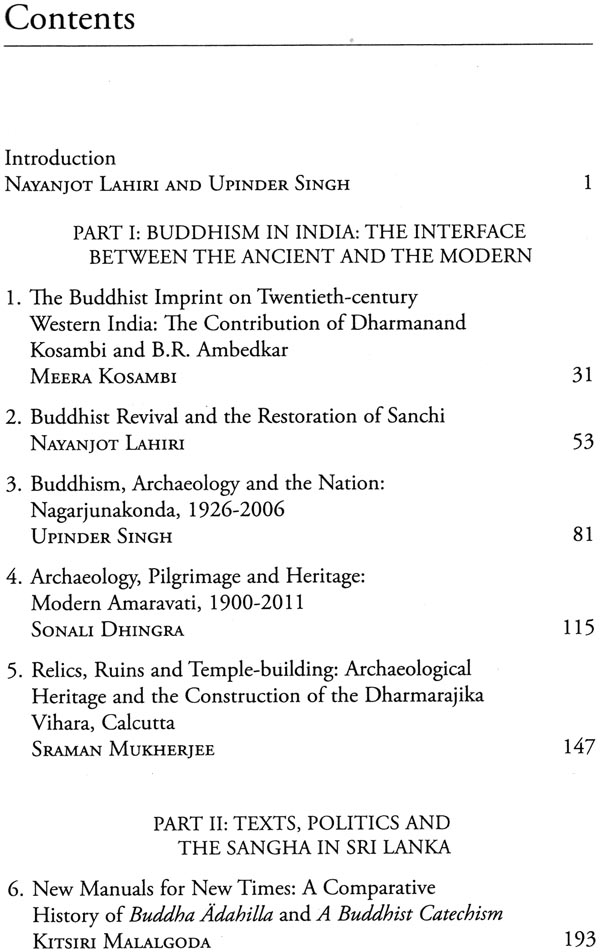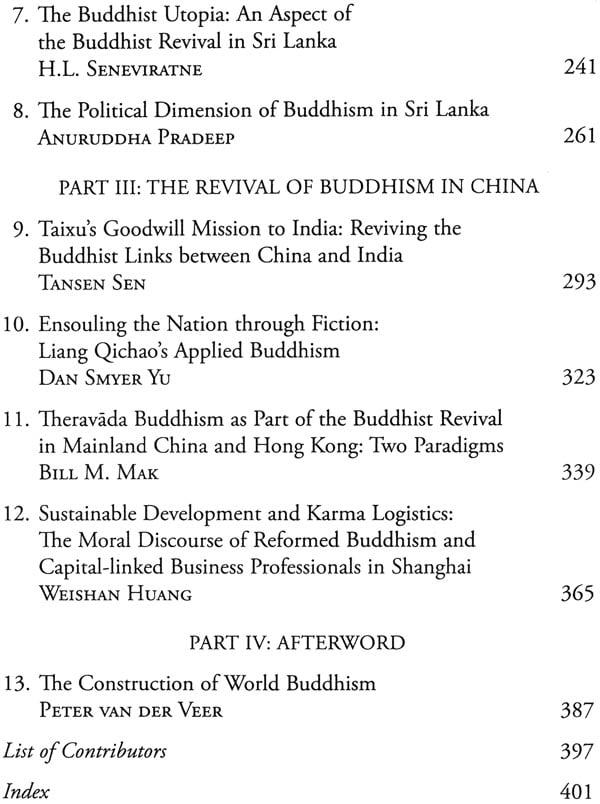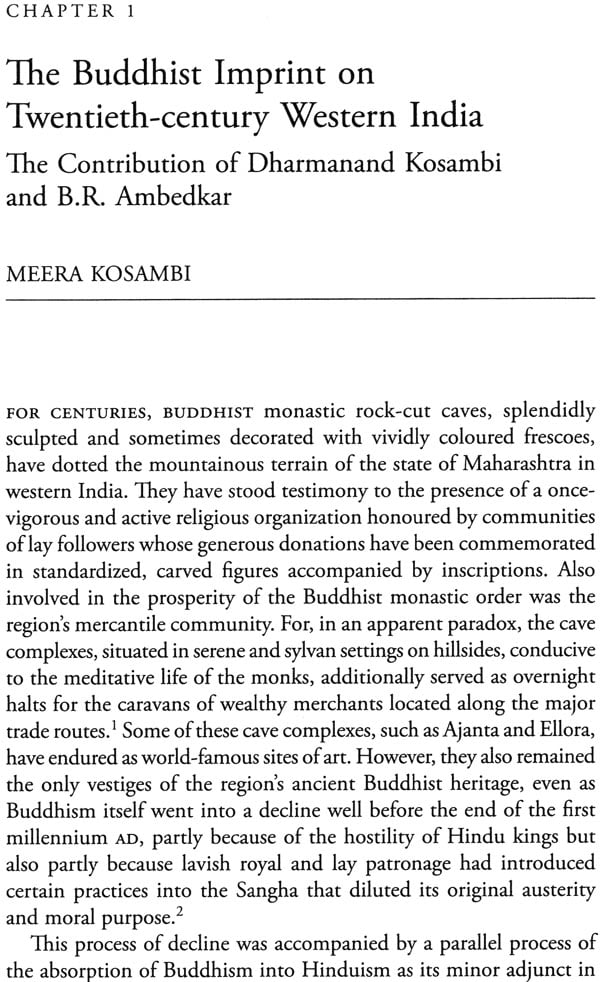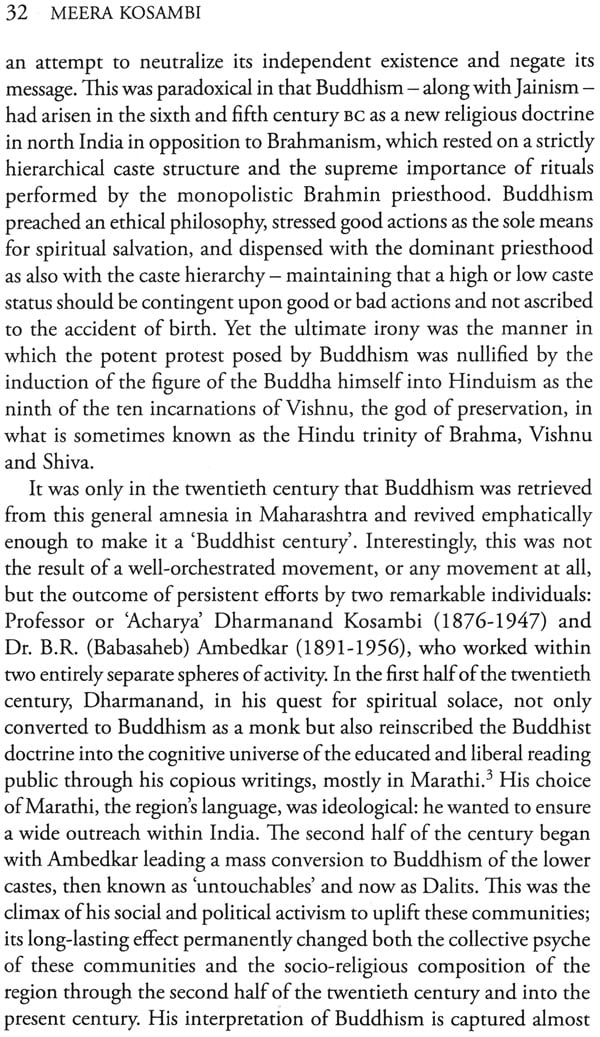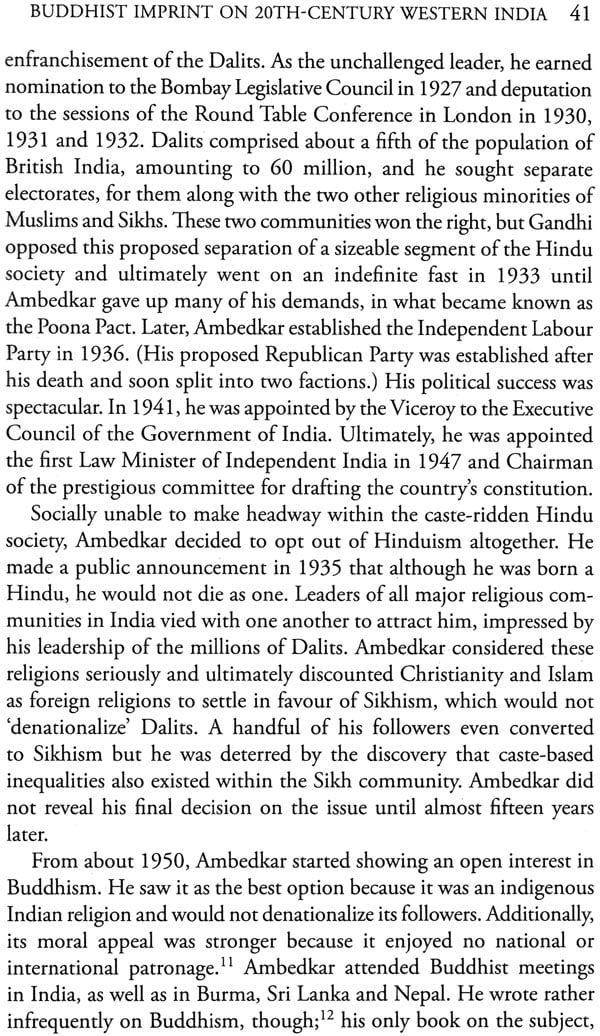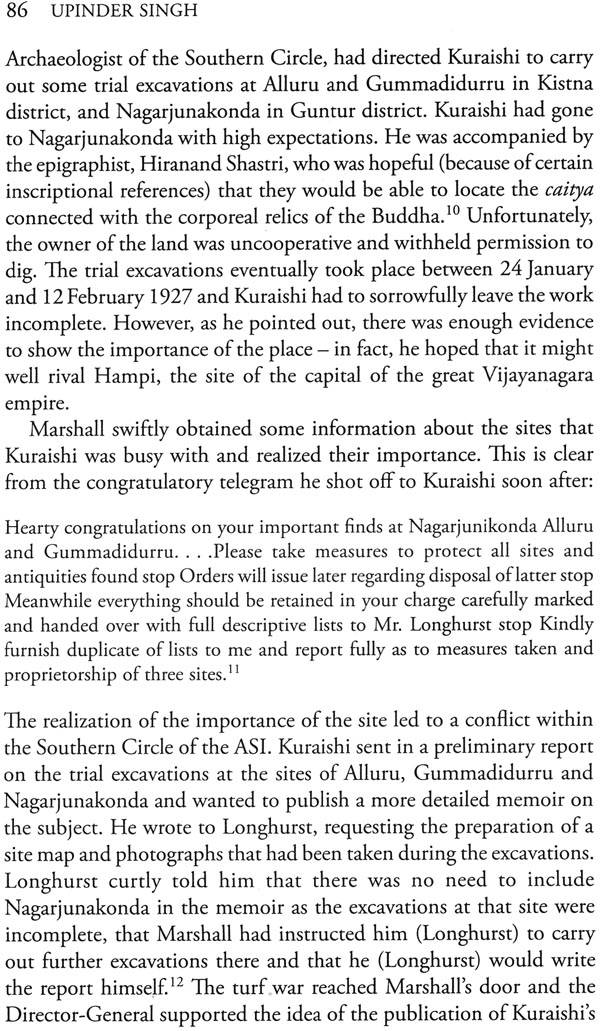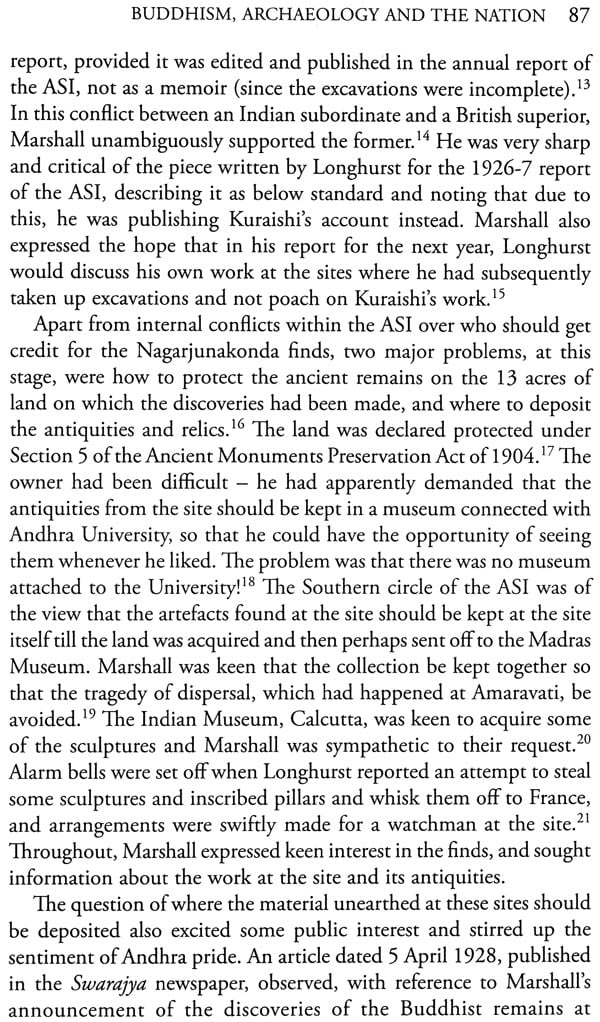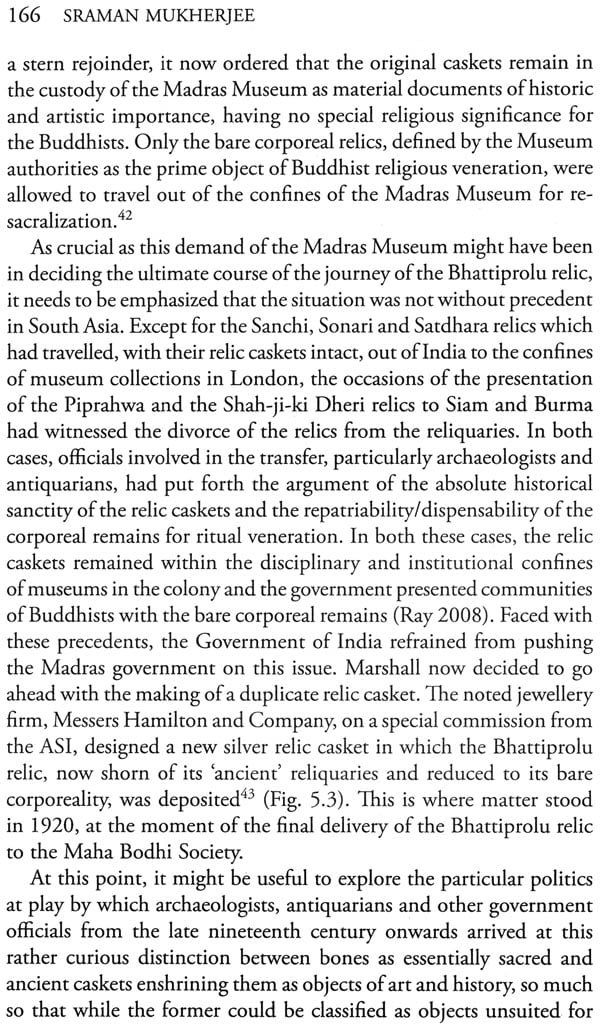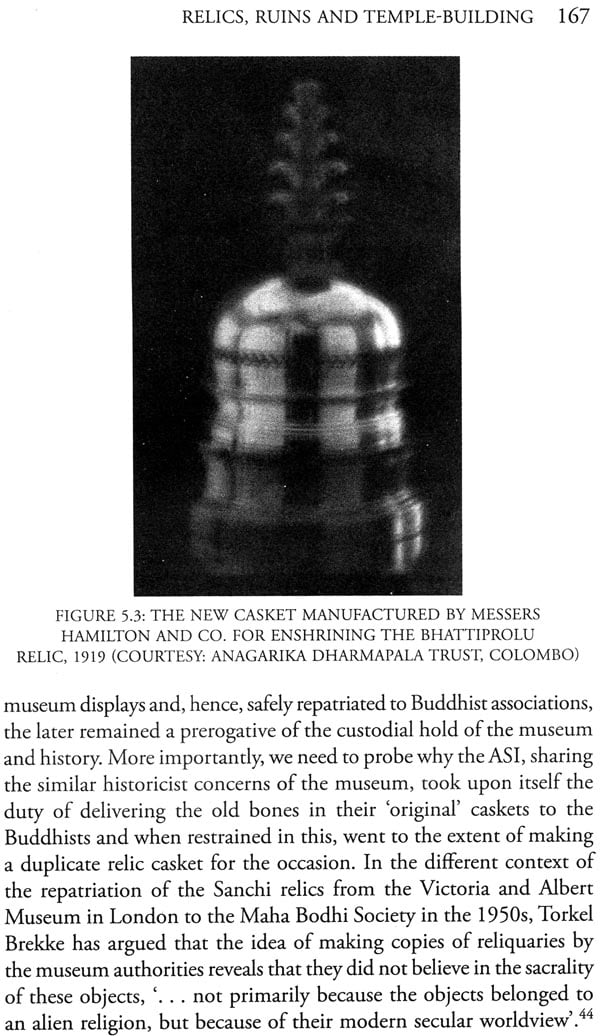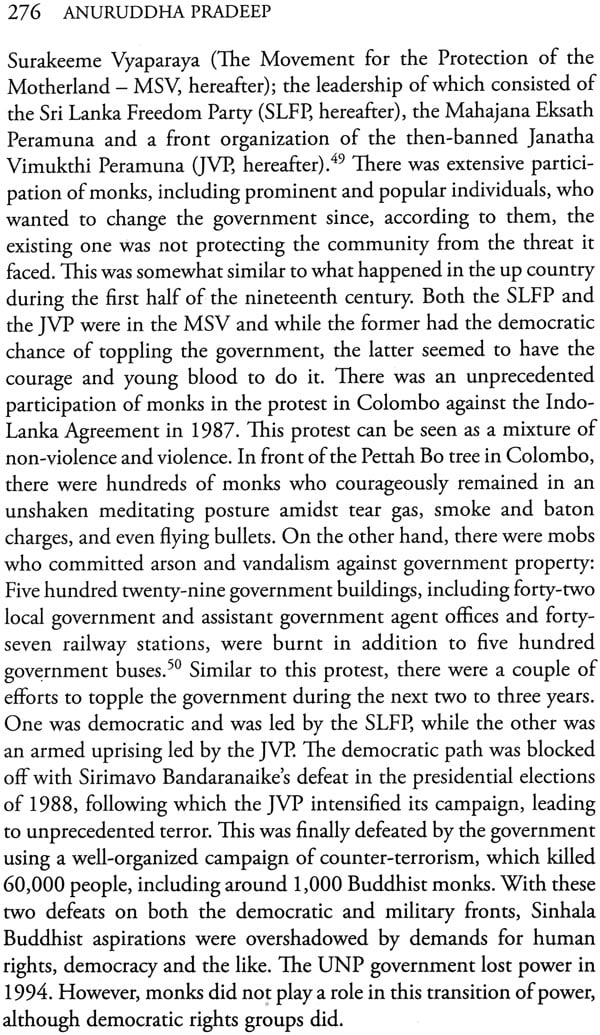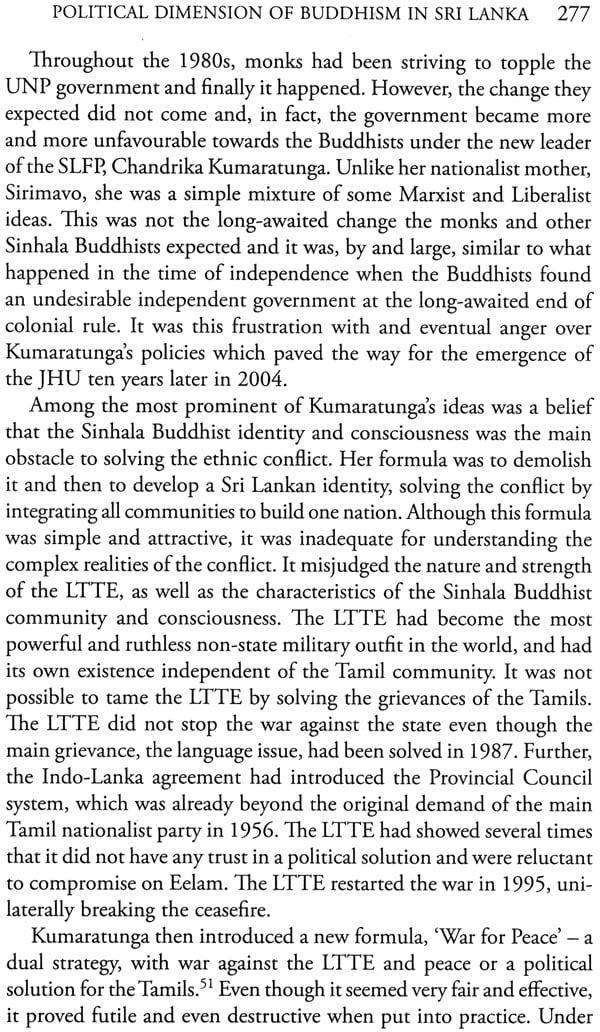
Buddhism in Asia (Revival and Reinvention)
Book Specification
| Item Code: | NAR361 |
| Author: | Nayanjot Lahiri and Upinder Singh |
| Publisher: | Manohar Publishers and Distributors |
| Language: | English |
| Edition: | 2016 |
| ISBN: | 9789350981160 |
| Pages: | 417 (8 B/W Illustrations) |
| Cover: | PAPERBACK |
| Other Details | 9.00 X 6.00 inch |
| Weight | 700 gm |
Book Description
The birth of Buddhism goes back to the sixth century BCE and, over the centuries, there has been considerable variety as well as considerable change in its doctrines, practices and propagation across the different parts of Asia. This volume showcases the expansion in the religion’s contours and popularity in Asia in modern times.
Focusing on India, Sri Lanka and China, the essays in the book highlight the cross-fertilization between Buddhism and contemporary discourses which makes the phenomenon of Buddhist revival in Asia unambiguously modern. They also show how this resurgence assumed a great variety of forms depending on the specificities of the historical and cultural context, including Buddhism’s with other religious traditions. Continuities with the past are not absent, and revivalist movements have been characterized and propelled by a strong sense of history and yet this, in effect, involved crafting new interpretations of a distant past, and the introduction of new ideas and practices. The term ‘reinvention’ seems to capture this aspect of dynamic change better than ‘revival’. At the same time, as this volume reveals, the choice of terms is not as important as tracing the trajectories of the phenomenon and the awareness that its impact extended far beyond the religious domain into many spheres, including those of cultural practice, national identity and international relations.
This is a historically rich and readable volume which will interest general readers as well as students and scholars of history and of Buddhism.
Nyanjot Lahiri is Professor of History at Ashoka University. Previously, she taught at the Department of History, University of Delhi. She established her reputation as an accessible historian of Indian antiquity with Finding Forgotten Cities: How the Indus Civilization was Discovered (2005). Her books include Marshalling the Past: Ancient India and its Modern Histories (2012) and The Archaeology of Indian Trade Routes (1993). Her most recent book is Ashoka in Ancient India (2015).
Upinder Singh is Professor and Head, Department of History, University of Delhi. Her books include Kings, Brahmanas, and Temples in Orissa: An Epigraphic Study (AD 300-1147) (1994); Ancient Delhi (1999); The Discovery of Ancient India: Early Archaeologists and the Beginnings of Archaeology (2004); A History of Ancient and Early Medieval India: From the Stone Age to the Twelfth Century (2008); Rethinking Early Medieval India (2011) and Asian Encounters: Exploring Connected Histories (co-edited, 2014).
This volume examines the many manifestations of the Buddhist revival in Asia. This revival is among the most striking pan-Asian cultural phenomena of modern times, stretching from India and Sri Lanka, across Myanmar and Thailand, to China and Japan. While `revival' is usually understood as a restoration of what had declined or disappeared to its original form, it is used here in a broader sense. `Revival', as deployed here, describes the varied developments and changes that took place in the practice and propagation of Buddhism, and the expansion in the religion's contours and popularity during the nineteenth and twentieth centuries, in ways that have continued well into the present. This led to the creation of a new kind of Buddhism which, instead of being derived from traditional forms, was explicitly modernistic in its formulations and practices. The term `reinvention' draws attention to this phenomenon.
The contributions that make up this volume were first presented at a conference on 'The Buddhist Revival in Asia held in Singapore in December 2010. The Indian High Commissioner of Singapore at the time, T.C.A. Raghavan, took the initiative of shepherding the conference, under the joint auspices of the Indian Council for Cultural Relations (New Delhi, India) and the Nalanda-Sriwijaya Centre at the Institute of Southeast Asian Studies (Singapore). The presence of some delegates was facilitated by the Max Planck Institute (Gottingen, Germany) and the Nalanda University (Bihar, India). This finally made possible a meeting of scholars from India, Sri Lanka, Nepal, Singapore, Hong Kong, Germany and the United States of America.
Asia is a vast landmass and a large part of it gets geographic coverage in this volume, from the coastline of Taiwan on the east to the western fringe of India. There are three segments of Asia that figure prominently here and, for this reason, the book's parts are organized around them, i.e. India, Sri Lanka and China (with Taiwan figuring in relation to its Buddhist interface with the Peoples Republic of China). Each of these parts has its own distinct flavour. In the case of India, the modern histories of iconic monuments and sites associated with early Buddhism — ranging from Sarnath and Sanchi to Nagarjunakonda and Amaravati — figure prominently. On the other hand, the Sri Lankan section focuses on the changing trajectory of modern Buddhist manuals, as also on those involved in the revival there, from Anagarika Dharmapala to an all-monk party, Jathika Hela Urumaya, which contested the 2004 parliamentary elections. In the case of China, the many forms of Buddhist revival are specifically assessed, qualitatively and statistically, to highlight the ways in which these were tempered by the broader political realities from the nineteenth century till the present.
At the same time, common themes and issues cut across the parts. There are several essays that examine the impact of political shifts on Buddhism's presence and profile. The trajectory of Nagarjunakonda in Andhra Pradesh in India is an example of this, a historic landscape whose dramatically diverse religious landscape came to be compromised as it was increasingly projected as a monochromatic Buddhist site, in consonance with the ideas of an influential section of the political leadership of post-Independence India. The political leadership of the People's Republic of China, on the other hand, has had a more ambivalent relationship with Buddhism. While, initially, it was supported by the Communist regime, during the 1960s and 1970s, the active hostility of the state, as seen in the Cultural Revolution, dramatically reduced the presence of temples and monasteries there.
The individuals that figure in this book — extraordinary ones who became monks (Dharmanand Kosambi in India and Taixu in China), reformer-nationalists who became icons of Buddhism (B.R. Ambedkar in India and Anagarika Dharmapala in Sri Lanka) and the creators of texts (Mohottivate Gunanda who compiled a Buddhist manual and Liang Qichao's political fiction that promoted a socially-engaged Buddhism) — may have led dissimilar lives. However, as various papers emphasize, there is, in each instance, a kind of cross-fertilization between Buddhism and contemporary discourses which makes them unambiguously modern. That their own lives and movements were aided by quicker modes of travel, publishing houses, Buddhist clubs and associations in what has been described as a 'Pan-Asian axis' among Buddhist adherents and sympathizers is also clearly highlighted. This was a time of rapid transformation, from South Asia to China, and the interactions among individuals, institutional interventions and agendas of reform produced a Buddhism that was both hybrid and modern. Notwithstanding efforts to provide ancient lineages to their programmes, as with attempts to re-sacralize Buddhist relics in India, or in the distinctly antique flavour invoked in restablishing China's cultural relations with other nations, it is its hybrid form that emerged from its encounter with modernism, which stands out in the story of the Buddhist revival in Asia.
What does this mean for the term 'revival'? Can it be considered an appropriate term for the resurgence of Buddhism in modern Asia? Was Buddhism across Asia in a state of decay? How does the great variety in the modern forms of Buddhism compare with earlier counterparts? In view of the creative religious innovations and changes in some regions, does 'reinvention' capture the character of modern Buddhism better than 'revival'? Readers will find that several of the essays in this book have engaged with the question of terminology and the nature of changes that Buddhism underwent in various national contexts. In a few nation states, 'revival' has meant the re-invigoration of Buddhism following some centuries of decline, while in other instances, it implies the resurgence of a religion that was under threat because of the policies of the political leadership. There are others where there was no marked decline prior to a Buddhist resurgence from the nineteenth century onwards. Again, in several instances, the new kinds of Buddhist formulations and sensibilities in Asia need to be seen as 'reinvented' avatars since instead of negotiating with traditional forms, these essentially represent attempts to 're-conceive Buddhism in modern terms'. Above all, what emerges from the themes explored here is that a comparative perspective provides a meaningful way to revisit the revival and reinvention of Buddhism in Asia.
BUDDHISM IN INDIA: THE INTERFACE BETWEEN THE ANCIENT AND THE MODERN
Before discussing the Buddhist revival in Asia, the process of its decline in its homeland, India, needs to be touched upon. It is clear that Buddhism did not completely disappear from the subcontinent. Several monastic centres such as Sanchi, Amaravati and Nalanda survived into medieval times, and there is a much longer, continuous and continuing Buddhist tradition in the western Himalayas, especially in the areas of Ladakh, Lahaul and Spiti. Yet there is no doubt that compared to its strong, visible and widespread presence and influence in the early historic period, Buddhism did witness a discernible marginalization in the subcontinent from the seventh century onwards. The idealization of Buddhism, which is a feature of many writings, right from the Western 'discovery' of Buddhism onwards, is implicit in some of the suggestions that have been put forward for its decline, such as the hypothesis that it was 'corrupted' by internal developments or tantric influence. Decline in royal patronage can only be a part of the explanation and a rupture in the sangha-laity bonds must have lain at the heart of the phenomenon.
While the decline of Buddhism in India during the medieval period is still inadequately understood, its revival is much better documented, and this forms the subject of the first part of this book. The essays here deal with various aspects of Buddhism in India between the nineteenth and twenty-first centuries, including local and international Buddhist revivalist organizations and movements, and the intersection of the revival with the histories of archaeology and Buddhist sites.
They also deal with Buddhist relics, an issue where archaeology, religious sentiment and international diplomacy converged. Some of the contributors have used hitherto untapped archival material to reconstruct the details of stories that are only sketchily known through published sources. Taken together, the essays reveal the intersection of the personal and the political, as well as the academic and the devotional understanding of Buddhism. They also reveal elements of continuity and change in the understanding of Buddhist sites and in the activities that coalesced around them over two centuries.
**Contents and Sample Pages**
